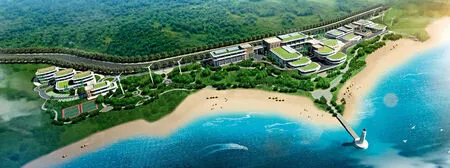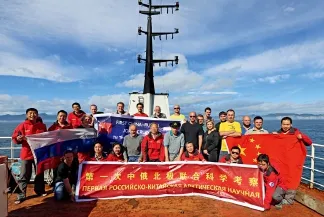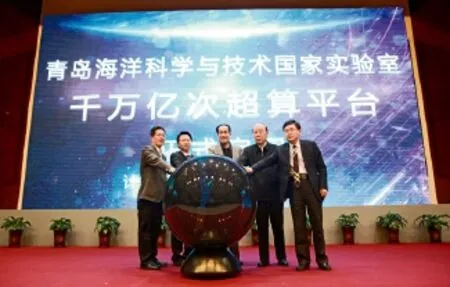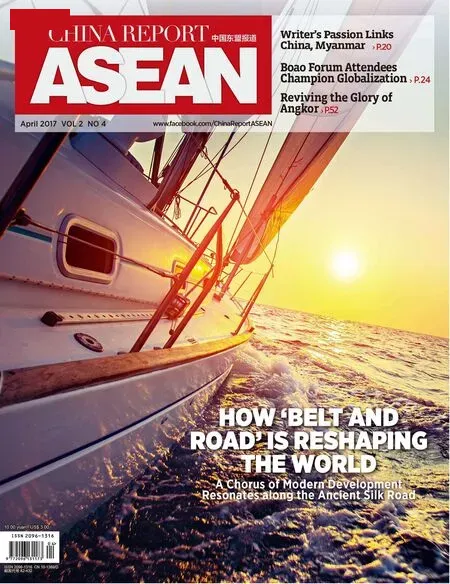Qingdao's Marine Research Dives Deep for Answers
By Wang Zhe
Qingdao's Marine Research Dives Deep for Answers
By Wang Zhe
China's coastal city makes increasingly great contribution to marine science and technology
As China’s economy has grown rapidly in recent decades, its attention to research of all kinds has increased too. With a 14,500-kilometer coastline, marine research has come to China’s the forefront, and the Qingdao National Laboratory for Marine Science and Technology (QNLM) in the eastern Chinese province of Shandong has taken on a leading role in marine science and technology innovation.
What makes the QNLM special? Last year, it achieved a number of major research results in areas including deep sea research, polar extreme environments and strategic resource exploration.
The QNLM published a total of 1,465 papers in 2016. Of them, 1,030 were included in Science Citation Index journals, and 39 could be seen in Nature, Science and other well known publications, outnumbering papers published by many of its internationally renowned counterparts over the course of the year.
Qingdao has transformed itself from keeping up with international advanced levels to leading the world’s marine innovation. By relying on the state-level marine research center, it has accelerated its pace of innovating marine science and technology, and has made ventures abroad.
Global Leader in Marine Science Innovation
The QNLM was approved and began operation on a trial basis in 2013, and was fully opened in October 2015. So far, it has set up eight laboratories: the Laboratory for Ocean and Climate Dynamics, the Laboratory for Marine Biology and Biotechnology, the Laboratory for Regional Oceanography and Numerical Modeling, the Laboratory for Marine Fisheries Science andFood Production Processes, the Laboratory for Marine Mineral and Resources, the Laboratory for Marine Drugs and Bioproducts, the Laboratory for Marine Geology and the Laboratory for Marine Ecology and Environmental Science.

A bird’s eye view of the eastern block of the Qingdao National Laboratory for Marine Science and Technology.
A team led by Professor Tian Jiwei from the Laboratory for Ocean and Climate Dynamics has conducted a scientific expedition of the Mariana Trench, the deepest part of the world’s oceans, using the Dongfanghong 2 research vessel. They gained first-hand observational data on the trench with self-developed marine equipment.
Additionally, China has completed its first joint Arctic research expedition with Russia. It has implemented more complete Arctic shelf research and promoted its deep sea science and technology innovation, keeping it at pace with globally advanced levels of deep sea innovation. Shi Xuefa, who served as the chief scientist of the expedition group, took on a leading role in such research as the director of the Laboratory for Marine Geology. Shi is also a researcher with the First Institute of Oceanography at the State Oceanic Administration.
To expand the blue economic space, the QNLM and the Chinese Academy of Fishery Sciences have jointly established the Science and Technology Innovation Alliance for Deep Blue Fisheries, set up a special program for sea projects and developed a number of core technologies and equipment for ocean observation, such as intelligent submarines and intelligent buoys. They have also implemented the 10,000 meter Deep Sea Action Plan and a program of charters for comprehensive study in the Yellow Sea and East China Sea. Furthermore, they have integrated the voyage resources of 16 scientific expedition vessels, and promoted the efficient sharing of equipment and survey data.
At the end of last year, the QNLM put into operation their High Performance Computing Center. Its computing capacity can reach 2,600 trillion processes per second, making it the fastest supercomputing system in the field of international marine scientific research. The QNLM will launch a marine data sharing platform and provide the first set of data in professional fields for its global counterparts. It is building a marine resources sharing platform with national influence, relying on its powerful supercomputing system, marine data sharing platform and a group of marine vessels including the Jiaolong Manned Submersible and the Xiangyanghong 01 and Kexue research vessels.
According to Wu Lixin, director of the QNLM and a professor at the Chinese Academy of Sciences, the QNLM is preparing to build the world’s third ocean-drilling vessel Dream together with the Geological Survey of China and the Qingdao government. Currently, only the US and Japan have this kind of vessel.
The initiative of “Building Partnerships on Ocean Observation and Research”, launched by the QNLM last year, has received positive responses from 20 countries and regions’marine institutions. As the East Asia Maritime Cooperation Platform is permanently based in Qingdao, China will develop marine partnerships with all East Asian countries and build a mechanism for East Asia marine cooperation.
The QNLM has joined hands with the Australia Commonwealth Scientific and Industrial Research Organization to build the Center for Southern Hemispheric Oceans Research in Hobart, Australia. The aim is to promote study of the Southern Oceans and the Antarctic. In the future, the QNLM will build other research bases with Russia, the UK, Germany and the US.
In 2016, the Laboratory for Marine Geology worked with Russia, Thailand and Malaysia to carry out a marine geological investigation.

Members of the first joint Chinese-Russian Arctic research expedition.
Remarkable Research Achievements
Since it officially beganoperations in October 2015, the QNLM has achieved many important research results and become a model for China’s national lab construction.
According to Wu Lixin, researchers have made major breakthroughs in the transparency of the cognitive system for the Western Pacific.
Meanwhile, the Laboratory for Regional Oceanography and Numerical Modeling has mastered a number of key technologies in cooperation with Tsinghua University and the National Supercomputing Center in Wuxi, Jiangsu Province. Researchers from the laboratory have demonstrated international space resolution of around one kilometer in ocean research with Chinese intellectual property rights for the first time internationally. The efficient parallel computing of the wave model has obtained great breakthroughs, as computation can reach speeds up to 45,430 trillion processes per second. With this achievement, it has been included as a nominee for this year’s Gordon Bell Prize, the highest possible prize for high performance computer applications.
Researchers have also made new progress in key technologies of marine biology genomics, including in wholegenome SNP typing, which is a core technology for analyzing the relations between genetic variation and the traits of the whole genome. Serial sequencing, successfully developed by the QNLM, can significantly reduce the cost of genome analysis. In addition, synchronous conjoint analysis of whole-Genome SNP typing and DNA methylation has been achieved for the first time.
To protect Antarctic krill, especially from ground-based predators feeding on them, the Convention for the Conservation of Antarctic Marine Living Resources, an Antarctic treaty system, is building a feedback management system for the Antarctic krill population. The acoustic detection data from fishing vessels is an essential part of the system. To interpret the noise recorded in acoustic data, researchers with the Laboratory for Marine Fisheries Science and Food Production Processes have developed an algorithm to eliminate interference noise.
Marine medicinal biological resources are strategic resources to develop new drugs for preventing and treating serious and complicated diseases. In 2016, the QNLM collected over 50 deep-sea samples from multiple areas and obtained more than 200 active fungi and ray fungi, which increased marine microorganism resourcess. In the meantime, it has also completed new discoveries in the research of drug lead compounds and provided scientific research support for the discovery of new marine drugs.
In 2016, the Laboratory for Marine Geology worked with Russia, Thailand and Malaysia to carry out a marine geological investigation. The investigation area covered the Bering Sea, the Sea of Okhotsk, the Sea of Japan, the Andaman Sea, open waters of f Sumatra, the Bay of Bengal and other vast seas from north to south. Thanks to the journey, data on sediment samples from all the aforementioned seas was obtained for the first time in human history.
By drilling four shallow holes at a mud volcanic structure where the heat flow values are high, researchers have obtained hydrate orebody samples for the first time. Two superficial layers of hydrate orebody were found 948-960 meters below the water level and 22-54 meters below the seafloor. Furthermore, the stimulation of the silty clay hydrate reservoir can play a key role in promoting the survey and pilot production of natural gas hydrate in the sea.
The research crew carried out in-depth studies on ecological disasters that broke out in China’s of f shore areas in recent years, such as large-scale red tides, green tides and jellyfish disasters. To prevent and control these disasters, they have come up with the strategy of “removing organisms and grass in advance”and studied the survival strategies of four large of f shore jellyfish species. The initial investigation shows that the brown tides in the waters near the Bohai Sea are responsible for the disasters.
Over the past year, the QNLM has also made new progress in research on hydrothermal activity at the South Mid-Atlantic Ridge. The researchers say that China has found more than 10 hydrothermal fields in the area, which makes it the country that has discovered the largest number of hydrothermal sulfide areas in the South Atlantic.

Top: The High Performance Computing Center at the Qingdao National Laboratory for Marine Science and Technology.

Bottom: The launch ceremony for the supercomputing system of the Qingdao National Laboratory for Marine Science and Technology.

